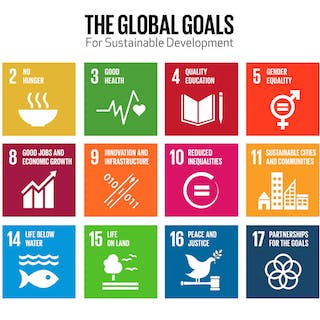In September, world leaders will gather at the United Nations to adopt the next set of global development goals, known as the Sustainable Development Goals.
We’ve gotten a lot of questions about the global goals, and we want to take a moment to answer some of the most common ones.
- What are the global goals?
The global goals serve as the world’s to-do list from 2016-2030. These goals form a shared agenda to end poverty, promote peace and opportunity for all, and protect the planet. Specifically, the 17 goals to be adopted in September are:
![]()
- Goal 1. End poverty in all its forms everywhere
- Goal 2. End hunger, achieve food security and improved nutrition and promote sustainable agriculture
- Goal 3. Ensure healthy lives and promote wellbeing for all at all ages
- Goal 4. Ensure inclusive and equitable quality education and promote lifelong learning opportunities for all
- Goal 5. Achieve gender equality and empower all women and girls
- Goal 6. Ensure availability and sustainable management of water and sanitation for all
- Goal 7. Ensure access to affordable, reliable, sustainable and modern energy for all
- Goal 8. Promote sustained, inclusive and sustainable economic growth, full and productive employment and decent work for all
- Goal 9. Build resilient infrastructure, promote inclusive and sustainable industrialization and foster innovation
- Goal 10. Reduce inequality within and among countries
- Goal 11. Make cities and human settlements inclusive, safe, resilient and sustainable
- Goal 12. Ensure sustainable consumption and production patterns
- Goal 13. Take urgent action to combat climate change and its impacts*
- Goal 14. Conserve and sustainably use the oceans, seas and marine resources for sustainable development
- Goal 15. Protect, restore and promote sustainable use of terrestrial ecosystems, sustainably manage forests, combat desertification, and halt and reverse land degradation and halt biodiversity loss
- Goal 16. Promote peaceful and inclusive societies for sustainable development, provide access to justice for all and build effective, accountable and inclusive institutions at all levels
- Goal 17. Strengthen the means of implementation and revitalize the global partnership for sustainable development
* Acknowledging that the United Nations Framework Convention on Climate Change is the primary international, intergovernmental forum for negotiating the global response to climate change.
- How do they work?
By providing concrete goals, the sustainable development agenda will mobilize action from across sectors and across the world. Governments, businesses, foundations, academics, civil society groups, entrepreneurs, and many others can leverage their strengths and resources to help achieve some or all of the goals.
Having a shared agenda also encourages governments, organizations, and people to come together and form partnerships for progress.
And by creating measurable goals to achieve, we can keep track of where we are doing well and where we need to do better, which helps citizens hold governments and others accountable for making progress. That’s why so many people have highlighted the importance of improving collection and use of data around the world.
- How were they decided?
UN Secretary-General Ban Ki-moon has called the creation of the new global goals “the most transparent and inclusive consultative process in UN history.”
UN Member States negotiated the global goals, which world leaders will formally adopt at a UN summit this September. The process to develop the global goals was supported by consultations with civil society groups, businesses, and more than 7 million global citizens who shared their priorities for the future.
- It’s an ambitious agenda, and 17 goals is a lot. Is progress possible?
Simply put: Yes!
We’ve made progress under global goals before. In 2000, world leaders and the UN created eight Millennium Development Goals to alleviate poverty and improve lives. These goals helped spur action that has saved millions of lives and improved millions more. For example, the number of out-of-school children of primary school age has nearly been halved since 2000 and as of last year, more than 13 million people living with HIV receive antiretroviral therapy – an astounding increase from 800,000 in 2003.
The 17 new global goals will continue the work of the Millennium Development Goals, while going even further to address the root causes of poverty. They reflect the complexity and interconnectedness of today’s social, economic, and environmental challenges. To achieve the change we need, we have to address our challenges in an integrated way, and that’s what the new agenda does.
The world has the resources, the know-how, and the technology to create a prosperous, sustainable future, but we need to unlock the will and the investments to make it happen. All of us – from governments to companies to citizens – have the opportunity to get involved, and together, we can make progress happen.
- Where can I learn more?
Here are some great resources to learn more about the global goals for sustainable development:
- How can I get involved?
Everyone can play a role in translating the goals from words on paper to change around the world.
Visit UN.org/action2015 to learn more and to connect with the UN.
Another great way to get involved is through Global Citizen, a community of people who want to learn about and take action on the world’s biggest challenges.
You can also join the UN Foundation email list to get updates on the global goals and how you can join the UN to create a better world.

